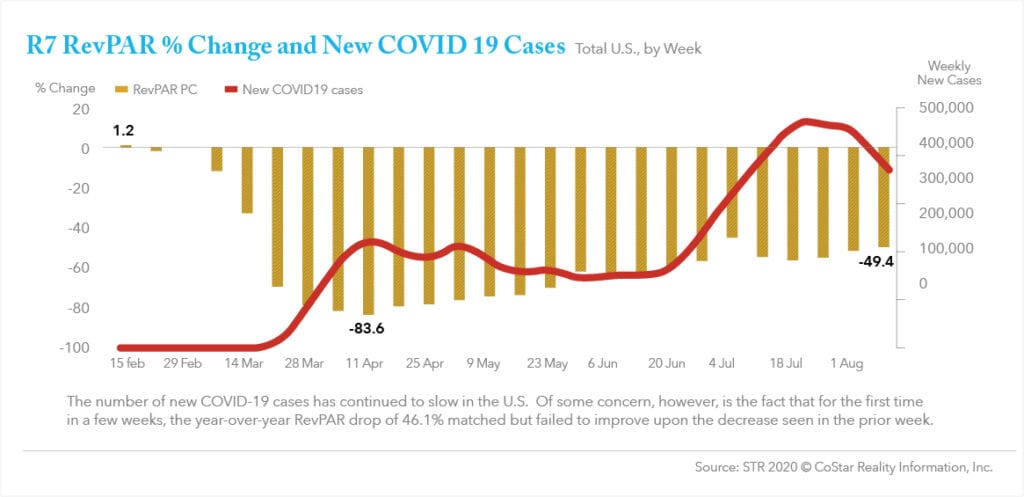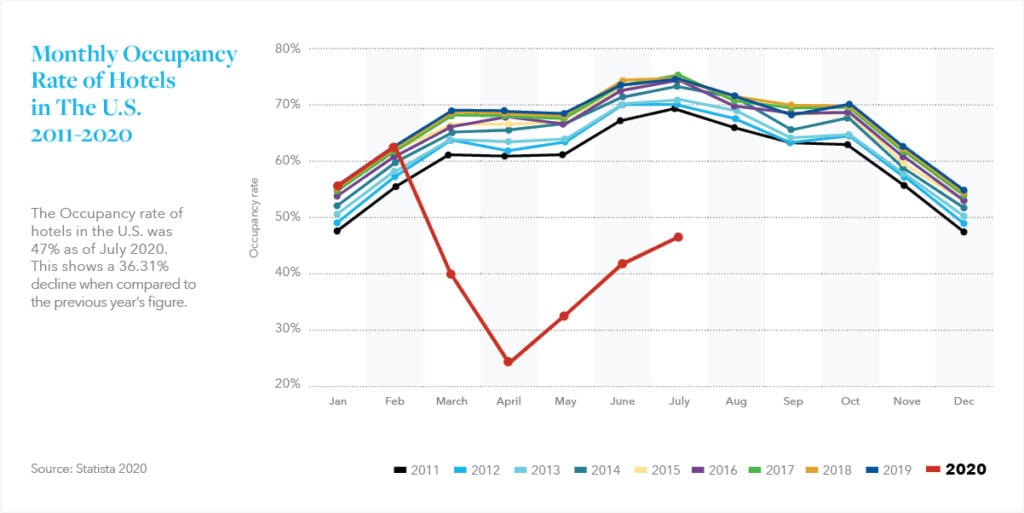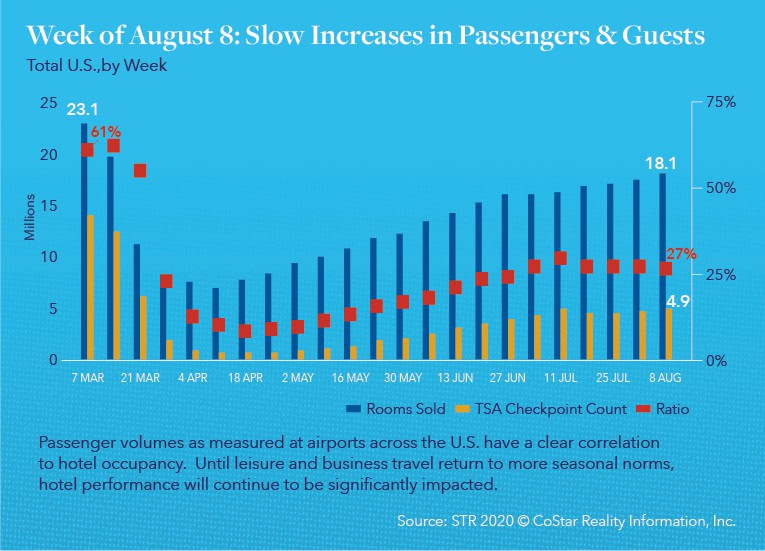In this article we take a look at the impacts to the hospitality market from the current global pandemic, and how factors ranging from airline travel to dynamic pricing and unemployment benefits are contributing to continued struggles and future planning complexity for hotels, even as occupancy rates have begun to recover.
With hotel chains such as Hilton Worldwide reporting a 77% Q2 revenue decline, many in the industry are bracing for a difficult road ahead, forecasting revenue per available room (RevPAR) declines in the 50% range for the entirety of 2020. According to CBRE, 2020 is projected to be the worst year on record for hotel occupancy, surpassing even the depths seen in 1933 during the Great Depression. With most hotels continuing to operate at significantly diminished staff levels, STR data shows that RevPAR remained flat for the week ended August 22, at -46.1%.
Considerations
The rapid shift from high levels of occupancy to unprecedented levels of vacancies has made it difficult for operators on many levels, including room pricing, which in recent years has grown more heavily dependent upon dynamic algorithmic modeling and trended data. With no historic precedent for the current environment, concerns have been expressed regarding the ability of these models to deliver the intended efficiencies and optimized pricing to which hospitality providers have grown accustomed. Given these considerations, we anticipate pricing to be a continuing struggle through at least Q3 and Q4 of this year.


By the end of April 2020, a large percentage of hotel employees had been laid off or furloughed since the onset of the crisis, resulting in billions in weekly lost wages. Oxford Economics estimated at that time that nearly 3.9 million total hotel-supported jobs had been lost since the crisis began. While some are now being recalled to their jobs as occupancy levels slowly climb, many of those unemployed are still not back at work. This has created concern in hospitality and other similar industries that these employees may seek alternative jobs and won’t be available if called back to work. Given this, there may be a costly need to sweeten the pot on both pay and benefits to attract and retain quality employees as the market recovers.
Although “drive-to” leisure demand is showing signs of life across the country given relaxed social distancing restrictions and continued hesitation about exposure at airports and onboard aircraft, some of the same factors have driven corporations to modify forecasts and cut budgets across their divisions. As a result, business travel is likely to remain down, with seminars and conventions going online rather than taking place in person, resulting in continued low occupancy. Among the hotel types we view as being most at risk during this period are those that are heavily reliant on: 1) large group bookings; 2) international travel and; 3) business driven by airport proximity.

A continued drop in hotel demand could see those structures ultimately used for other asset-class purposes. During the current period, some properties report that they have contracted with universities to house students for the fall based on dormitory capacity issues pertaining to social distancing. Additionally, some local community support groups, charitable organizations and government agencies have worked with operators to place homeless COVID-19 patients at hotel and motel properties in parts of the country.
Historic data highlights that economic downturns are not kind to the hospitality industry. Periods of GDP contraction closely correlate to decreases in hotel RevPAR and have historically led to declining values, driven in large part by lender/investor risk aversion. We see this dynamic evolving in the current environment with a potentially significant decline in asset values estimated at between 20% and 35%, and, ultimately, buyers actively seeking to purchase properties at a significant discount to pre-pandemic levels as the market bottoms out.
With EBITDA down and a challenging debt market, buyers with strong cash positions will have an advantage in the hunt for the properties during the slide, as well as at the early stages of the low point. But for distressed property owners and lenders with those assets in their portfolios, the question that remains is: When is the right time to market those hospitality assets for sale and what incentives – such as seller financing – may need to be given to facilitate those transactions? That said, based on both our experience and proprietary trended industry data, from a sales marketability perspective, hotels that have suspended operation during this period are likely to be viewed somewhat more favorably than those that close under other circumstances, particularly if 3- to 5-year pre-pandemic performance supports the assumption that those properties should be able to resume profitable operations when the worst of COVID-19 is in the rear view mirror.
Conclusions
While vacancy rates have improved from their highs of near 80% at the beginning of April, properties that have remained open continue to do so with minimal staffing. According to a study of its members conducted in late July by the American Hotel & Lodging Association (AHLA), nearly 90% of the 1,200 respondents indicated that they have laid off or furloughed employees due to the COVID-19 crisis. Only 37% stated that they have been able to bring back at least half of their full-time employees, and 29% said they still remain at or below a 20% staffing level. Six hundred of those responding to the survey were, themselves, hotel owners. Of those, more than half indicated that they are now in danger of losing their property to foreclosure by commercial real estate lenders.
Inevitably, it is likely that many hotels will not be able to recover and will come on the market for sale either by current ownership or a lender. Hilco advises that hotel owners who had previously been considering selling – as well as those with a high degree of certainty that the need for a sale due to recent events may be necessary in the coming six months – should begin taking the appropriate steps now to get those properties on the market. At present, we are seeing buyers still actively looking and there is, without question, less inventory on the market than there will be in 2021. Throughout this period, we are working closely with owners and lenders and are in regular contact with many stakeholders across the industry. Hotel owners who have questions or concerns, are interested in obtaining a needs assessment on a single location or multiple properties within a portfolio, or who would simply like to gain some added perspective… please give us a call. The experts at Hilco can help during this challenging time.
Hilco Real Estate is a unit of Hilco Global, specializing in the sale and auction of hotels and hotel notes throughout North America. Hilco is one of the industry’s most respected and accomplished authorities on real estate and note dispositions, including the sale of full-service and limited-service hotels. Clients rely on our vast experience and comprehensive set of tools, such as a proprietary database of thousands of hotel buyers/operators and Hilco/hospitality broker partnerships to help expedite sales. Providing strategic advisory and transactional services designed to minimize costs and maximize value of real estate assets for both healthy companies and companies in transition, our expertise spans situations including: flagged/unflagged, bank-owned, operating/non-operating, private owners/REITs, nationwide coverage and performing and non-performing note sales. Over the past few years alone, Hilco Real Estate has monetized over $1 billion in owned and leased real estate through traditional property listings and auction services.



